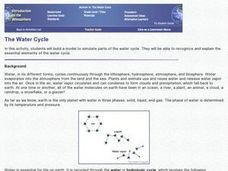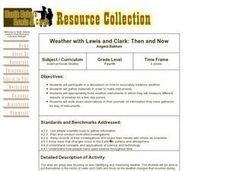Curated OER
Weather Watchers
Students identify basic weather instruments and how they are used to record weather data. Students define several vocabulary terms as stated in lesson. Students use basic instruments to record weather data in their area. Students use the...
Curated OER
The Water Cycle--Model Simulation
Students build a model to simulate parts of the water cycle. They recognize and explain the essential elements of the water cycle.
Curated OER
Eruption
Students conduct an experiment simulating an underwater volcano based on reading The Magic School Bus Blows Its Top. They create a desktop volcano eruption demonstrating where magma comes from and how lava flows.
Curated OER
Storm That Drowned a City
Young scholars use a map to locate New Orleans and watch a video on the destruction of Hurricane Katrina. As a class, they watch a demonstration on how a wetland can reduce the impact of a hurricane. In groups, they perform their own...
Chicago Botanic Garden
Causes and Effects of Climate Change
Wrap-up a unit on global climate change with a lesson that examines the causes and effects of climate change. Learners fill out a chart that represents what they think causes climate change—natural and human-based—and what they think...
Curated OER
Fossil Formation
Students discuss fossils. In this science lesson, students simulate fossils within Earth's layers by using gummy fish and bread.
Curated OER
Wave Equations
Students manipulate a model of a wave in order to solve the wave equation in 1 dimension. By using a model of a wave on a string the student is able to change the tension, length, and mass of the string as well as fix either end of the...
Curated OER
Pop Rockets
Pupils work together to design and build a paper rocket. They place a propellant in the contraption to make it fly. They discover Newton's third law of motion.
Curated OER
Relational Causality
Students explore the concept of Bernoullii's Principle and how it behaves. Have each student fold the piece of paper in half. Then have them place the paper like a tent on a smooth surface. Have them blow under it (they can use a straw...
Curated OER
Deadly Ascent
High schoolers explore some of Earth's extreme environments and the possible dangers they present. They describe some of the potential dangers found in extreme environments around the world. Students discuss ways to deal with potential...
Curated OER
Build Your Own Hovercraft
Learners construct a hovercraft following specific procedures. In this technology lesson plan, students explain the physics principles behind hovercraft. They compare and contrast this machine with the aircraft.
Curated OER
Designing Windmills
Students study mechanical engineering and how it plays a part in the creation of windmills. They design and test their own windmills using various materials and sail designs.
Curated OER
DEW POINT
Fourth graders investigate conditions causing saturation and measure the dew point of the atmosphere performing simple experiments.
Curated OER
Flight
Learners are introduced to the four forces of flight--drag, lift, thrust, and weight--through a variety of fun-filled flight experiments. They "fly" for short periods and evaluate factors that might either increase or decrease their...
Curated OER
Testing and Refining Aircraft Design
High schoolers design and make a flying device. They work in small groups to brainstorm ideas for the design of their device. They choose an idea or combination of ideas to use for their design and create a sketch of their design. The...
Curated OER
Lift and Launch Angle
Young scholars engage in a hands-on experiment to determine how launch angles affect airflow around the wing of an aircraft. They view a series of photographs and read information describing the Wright Brothers' experiences. They...
Curated OER
Project X-35
Students demonstrate rocketry principles through a cooperative, problem solving simulation. They work in teams to simulate the development of a commercial proposal to design, build, and launch a rocket.
Curated OER
Weather with Lewis and Clark: Then and Now
Fourth graders discuss how to accurately measure weather, gather materials in order to make instruments, and build weather instruments in which they measure and record different aspects of weather for a five-day period.
Curated OER
Paper Dart Airplane
Students create a paper dart airplane and measure its flight pattern. In this flight instructional activity, students follow the included directions to build their own paper airplane. The students change the aileron configurations to see...
Curated OER
Cyclones
Students explore Earth science by researching natural disasters in class. In this cyclone lesson, students discuss the creation of cyclones and what their potential destruction can be in the wrong environment. Students read assigned text...
Curated OER
Bubble-ology and Bernoulli
Students explore aerodynamics and Bernoulli's principle by devising ways to keep bubbles aloft.
Nuffield Foundation
Measuring the Rate of Metabolism
Plant respiration can be a difficult concept for young biologists to grasp; with a hands-on lab, learners can collect and graph data, then calculate the metabolism rate for the plants they studied. If you do not have a respirometer,...
Nuffield Foundation
Measuring Respiratory Quotient
How do scientists prove tiny living things respire? Young scientists build a respirometer and measure respiration rates in living creatures. By comparing the measurements of both plants and animals, they understand the similarities.
Council for Economic Education
Inflation Data: Is the Economy Healthy?
What stories do current trends tell about society, fashion, and the future? Scholars investigate the concept of inflation and its impact on the future of the American economy. They compile current economic data to determine the level of...























